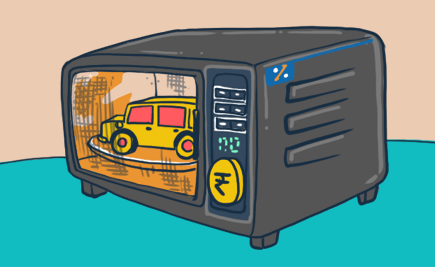You don’t completely own your car until you repay your Car Loan and remove the hypothecation from your registration certificate (RC). You will then get a new smart card. Here’s how it’s done.
People often make the mistake of thinking that the car is theirs as soon as their Car Loan is over. This is far from the truth. An oft-forgotten fact is that when a Car Loan is taken, the Registration Certificate (RC) is in the name of the lender who provides the Car Loan. You have essentially hypothecated your car to the financial institution from which you borrowed money to buy that car. Why hypothecation? This is done to ensure that you don’t sell the car until you repay the loan taken.
If you want the car to be truly yours, as soon as you finish repaying the Car Loan, you should complete the process of removing the hypothecation and getting the car transferred to your name. Yes, this can be done through an agent. But you needn’t waste your money by paying an agent for this. The process is really simple and cost-effective and you could do it by yourself. Here are the steps.
Step 1. Get the NOC, Form 35
As soon as you close your loan, your bank should provide you with the documents for loan closure. This will include a No Objection Certificate (NOC). Check your Car Loan documents to see within what time frame your lender has to send you the closure documents. Usually, the time frame is about a week or a fortnight.
Closure documents are those that will certify that you have repaid the whole loan and the loan account has been closed. These documents include the NOC stating that no amount is pending from you towards the loan. Another document is Form 35. This will state that your hypothecation agreement with the bank can be terminated.
The closure documents sent by the bank are generally valid for about 3-6 months from the date of issue unless otherwise stated in the document. If you closed your Car Loan a while ago, you might need to get a fresh set of documents as your Regional Transport Office (RTO) office might say that old documents are no longer valid. Also, you may want to get at least 2-3 copies of the NOC. One for yourself, one for the RTO and one for the Car Insurance company if they want it.
BB Tip: Ensure that the NOC is on the bank’s letterhead and you have a duplicate of Form 35.
Additional Reading: Foreclosing Your Car Loan: Is It A Good Idea?
Step 2. Gather other documents
Apart from the above-mentioned documents, you need to have other documents related to your car. This includes copies of your Car Insurance, PAN Card, address proof and Pollution Under Control (PUC) certificate. You also need your original registration certificate along with a copy of your driving license.
BB Tip: Wherever you have copies made of documents, you might want to get them attested. Usually, RTOs in cities like Delhi and Mumbai need you to get copies of the documents attested by a gazetted officer. And note that you will need Form 33 in case your current address is not the same as the address on your RC. You can staple all the copies together before submitting them for verification at the RTO.
Step 3. Visit your RTO
To cancel your hypothecation, you need to go to the RTO at which you registered the vehicle. It isn’t possible to do this at any other RTO, unfortunately.
Ask around to find out who the verification officer is. Submit all your documents to the verification officer at the RTO. The officer will enter the details into the system. Another officer will approve the details entered into the system. Then, you need to go to the payment counter to pay the hypothecation cancellation fee. Submit all your documents to the officer who approved your documents. Show the officer the proof of payment. You will be given a date on which you can come back to the RTO.
Additional Reading: Car Loan Application 101
There is an additional step for some RTOs. The RTO will provide you with an application letter for cancellation of hypothecation after verification. Submit these to the bank which granted you the Car Loan. Your bank will provide you with a confirmation letter containing an outward number. Given this number to the RTO. Note that some RTOs may not need this confirmation letter. Check with your RTO regarding this.
On the date specified by the officer, visit the RTO and collect your documents along with an ‘acceptance form’. You can make corrections on the acceptance form if details like your name is wrong. Sign the form and give it to the officer. Take all your documents and pay the fees for a fresh RC smart card. You might need to pay an additional fee for the change of address.
Most RTOs today give a smart card as the RC and not a book. The total fees generally range between Rs. 300 and Rs. 1,000 depending on your RTO. The RTO provides receipts for the fees paid. Some RTOs send the card by post while others might ask you to collect it from them. It usually takes 4 days to a month to get the new RC smart card.
Ta-da! You’re done. Congratulations! The car is now truly yours. All yours!
Psst… If you’re planning to sell your car off and get another chariot with a Car Loan, perhaps we can help?
